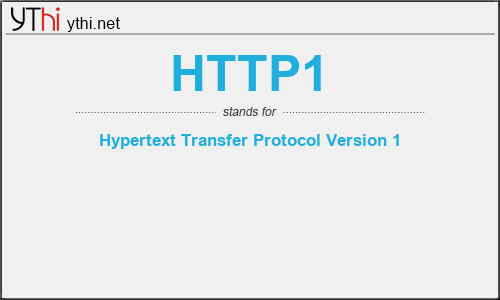What does HTTP1 mean? What is the full form of HTTP1?
1, The full form of HTTP1 is Hypertext Transfer Protocol Version 1
The Hypertext Transfer Protocol (HTTP) is an application-level protocol with the lightness and speed necessary for distributed, collaborative, hypermedia information systems. It is a generic, stateless, object-oriented protocol which can be used for many tasks, such as name servers and distributed object management systems, through extension of its request methods (commands). A feature of HTTP is the typing of data representation, allowing systems to be built independently of the data being transferred.
HTTP has been in use by the World-Wide Web global information initiative since 1990. This specification reflects common usage of the protocol referred to as “HTTP/1.0”.
The Hypertext Transfer Protocol (HTTP) is an application-level protocol with the lightness and speed necessary for distributed, collaborative, hypermedia information systems. HTTP has been in use by the World-Wide Web global information initiative since 1990. This specification reflects common usage of the protocol referred to as “HTTP/1.0”. This specification describes the features that seem to be consistently implemented in most HTTP/1.0 clients and servers. The specification is split into two sections. Those features of HTTP for which implementations are usually consistent are described in the main body of this document. Those features which have few or inconsistent implementations are listed in Appendix D.
Practical information systems require more functionality than simple retrieval, including search, front-end update, and annotation. HTTP allows an open-ended set of methods to be used to indicate the purpose of a request. It builds on the discipline of reference provided by the Uniform Resource Identifier (URI) as a location (URL) or name (URN) , for indicating the resource on which a method is to be applied. Messages are passed in a format similar to that used by Internet Mail and the Multipurpose Internet Mail Extensions (MIME)
HTTP is also used as a generic protocol for communication between user agents and proxies/gateways to other Internet protocols, such as SMTP , NNTP , FTP , Gopher , and WAIS , allowing basic hypermedia access to resources available from diverse applications and simplifying the implementation of user agents.
HTTP/1.1 has been around for more than a decade. With Google’s SPDY leading the way in 2015, the IETF (Internet Engineering Task Force) gave us HTTP/2, which introduces several features to reduce page load times. Let’s compare HTTP2 Vs. HTTP1.1 in detail.
HTTP/2 achieves faster webpage loading without performance optimizations that require extensive human efforts in terms of development. It significantly reduces the complexities that had crept into HTTP/1.1 and gives us a robust protocol which, though not without its flaws, will perhaps stand the test of time. Before making this leap forward, let’s trace our steps back to when the internet was in its infancy to understand how the different versions evolved into the current form.
see also What does HTTP2 mean? What is the full form of HTTP2?
see also What does HTTP1 mean? What is the full form of HTTP1?
see also What does HTTP3 mean? What is the full form of HTTP3?
HTTP1
means
Hypertext Transfer Protocol Version 1![]()
Translate Hypertext Transfer Protocol Version 1 to other language.


Leave a Reply
You must be logged in to post a comment.